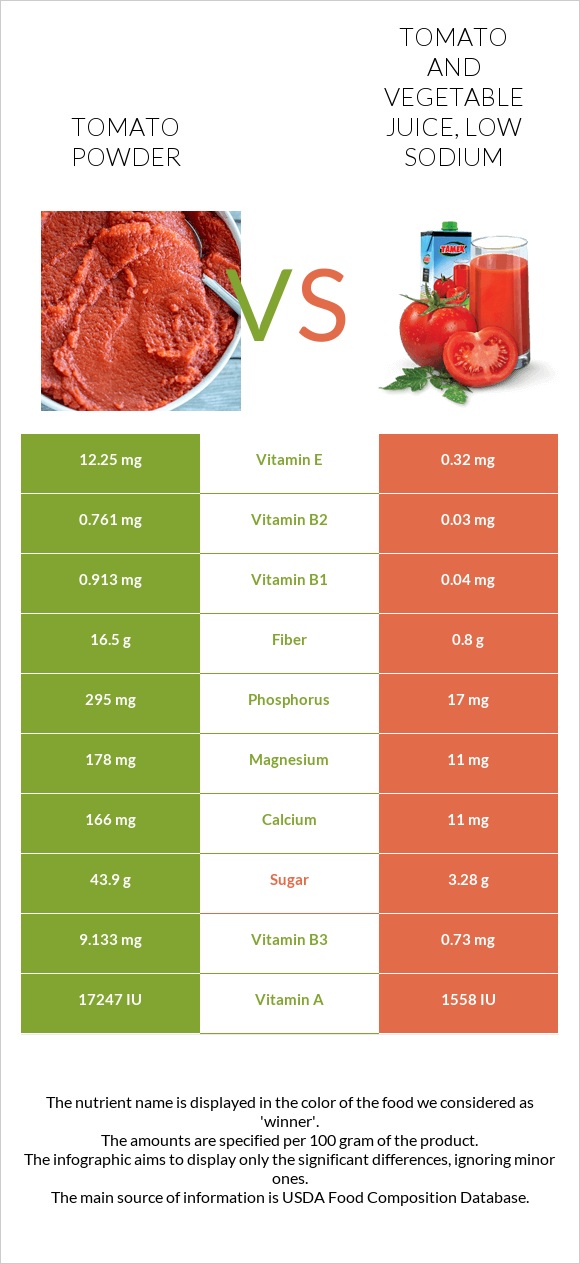Tomato powder vs. Tomato and vegetable juice, low sodium — In-Depth Nutrition Comparison
Compare
Summary of differences between tomato powder and tomato and vegetable juice, low sodium
- Tomato and vegetable juice, low sodium has less vitamin A, copper, vitamin C, vitamin E, vitamin B1, fiber, vitamin B2, vitamin B3, iron, and potassium than tomato powder.
- Tomato powder covers your daily need for vitamin A, 314% more than tomato and vegetable juice, low sodium.
- Tomato powder has 38 times more vitamin E than tomato and vegetable juice, low sodium. While tomato powder has 12.25mg of vitamin E, tomato, and vegetable juice, low sodium has only 0.32mg.
These are the specific foods used in this comparison Tomato powder and Tomato and vegetable juice, low sodium.
Infographic

Infographic link
Mineral Comparison
Mineral comparison score is based on the number of minerals by which one or the other food is richer. The "coverage" charts below show how much of the daily needs can be covered by 300 grams of the food.
| Contains more MagnesiumMagnesium | +1518.2% |
| Contains more CalciumCalcium | +1409.1% |
| Contains more PotassiumPotassium | +898.4% |
| Contains more IronIron | +985.7% |
| Contains more CopperCopper | +520.5% |
| Contains more ZincZinc | +755% |
| Contains more PhosphorusPhosphorus | +1635.3% |
| Contains more ManganeseManganese | +∞% |
| Contains more SeleniumSelenium | +960% |
| Contains less SodiumSodium | -56.7% |
Vitamin Comparison
Vitamin comparison score is based on the number of vitamins by which one or the other food is richer. The "coverage" charts below show how much of the daily needs can be covered by 300 grams of the food.
| Contains more Vitamin CVitamin C | +321.3% |
| Contains more Vitamin AVitamin A | +1005.1% |
| Contains more Vitamin EVitamin E | +3728.1% |
| Contains more Vitamin B1Vitamin B1 | +2182.5% |
| Contains more Vitamin B2Vitamin B2 | +2436.7% |
| Contains more Vitamin B3Vitamin B3 | +1151.1% |
| Contains more Vitamin B5Vitamin B5 | +∞% |
| Contains more Vitamin B6Vitamin B6 | +226.4% |
| Contains more Vitamin KVitamin K | +820.8% |
| Contains more FolateFolate | +471.4% |
All nutrients comparison - raw data values
| Nutrient |  |
 |
DV% diff. |
| Copper | 1.241mg | 0.2mg | 116% |
| Vitamin C | 116.7mg | 27.7mg | 99% |
| Vitamin A | 862µg | 78µg | 87% |
| Manganese | 1.951mg | 85% | |
| Vitamin E | 12.25mg | 0.32mg | 80% |
| Vitamin B5 | 3.76mg | 75% | |
| Vitamin B1 | 0.913mg | 0.04mg | 73% |
| Fiber | 16.5g | 0.8g | 63% |
| Vitamin B2 | 0.761mg | 0.03mg | 56% |
| Vitamin B3 | 9.133mg | 0.73mg | 53% |
| Iron | 4.56mg | 0.42mg | 52% |
| Potassium | 1927mg | 193mg | 51% |
| Magnesium | 178mg | 11mg | 40% |
| Phosphorus | 295mg | 17mg | 40% |
| Vitamin K | 48.8µg | 5.3µg | 36% |
| Protein | 12.91g | 0.6g | 25% |
| Folate | 120µg | 21µg | 25% |
| Vitamin B6 | 0.457mg | 0.14mg | 24% |
| Carbs | 74.68g | 4.59g | 23% |
| Calcium | 166mg | 11mg | 16% |
| Calories | 302kcal | 22kcal | 14% |
| Zinc | 1.71mg | 0.2mg | 14% |
| Selenium | 5.3µg | 0.5µg | 9% |
| Sodium | 134mg | 58mg | 3% |
| Fats | 0.44g | 0.1g | 1% |
| Choline | 7.2mg | 1% | |
| Polyunsaturated fat | 0.179g | 0.042g | 1% |
| Protein per 100 calories | 4.274834437086093g | 2.727272727272727g | N/A |
| Net carbs | 58.18g | 3.79g | N/A |
| Sugar | 43.9g | 3.28g | N/A |
| Saturated fat | 0.062g | 0.014g | 0% |
| Monounsaturated fat | 0.066g | 0.016g | 0% |
| Tryptophan | 0.089mg | 0% | |
| Threonine | 0.295mg | 0% | |
| Isoleucine | 0.25mg | 0% | |
| Leucine | 0.359mg | 0% | |
| Lysine | 0.37mg | 0% | |
| Methionine | 0.066mg | 0% | |
| Phenylalanine | 0.273mg | 0% | |
| Valine | 0.264mg | 0% | |
| Histidine | 0.204mg | 0% |
Macronutrient Comparison
Macronutrient breakdown side-by-side comparison
Protein:
12.91 g
Fats:
0.44 g
Carbs:
74.68 g
Water:
3.06 g
Other:
8.91 g
Protein:
0.6 g
Fats:
0.1 g
Carbs:
4.59 g
Water:
93.5 g
Other:
1.21 g
| Contains more ProteinProtein | +2051.7% |
| Contains more FatsFats | +340% |
| Contains more CarbsCarbs | +1527% |
| Contains more OtherOther | +636.4% |
| Contains more WaterWater | +2955.6% |
Fat Type Comparison
Fat type breakdown side-by-side comparison
Saturated fat:
Sat. Fat
0.062 g
Monounsaturated fat:
Mono. Fat
0.066 g
Polyunsaturated fat:
Poly. Fat
0.179 g
Saturated fat:
Sat. Fat
0.014 g
Monounsaturated fat:
Mono. Fat
0.016 g
Polyunsaturated fat:
Poly. Fat
0.042 g
| Contains more Mono. FatMonounsaturated fat | +312.5% |
| Contains more Poly. FatPolyunsaturated fat | +326.2% |
| Contains less Sat. FatSaturated fat | -77.4% |